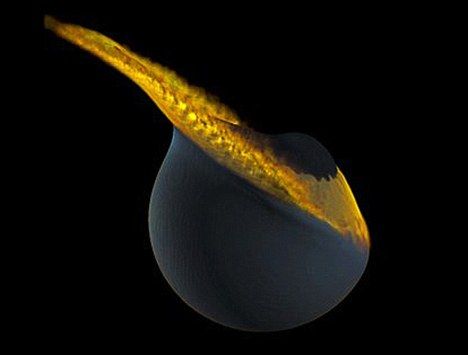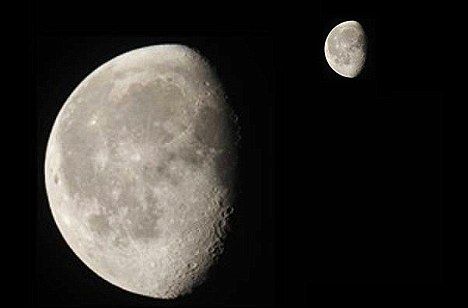
科学家认为,当两颗卫星相撞时,月球可以吸收它的姊妹卫星的一些材料

地球可能曾有两颗卫星,一颗现在正照耀着我们的夜空,另一颗稍小一些
北京时间8月4日消息,根据一项最新提出的理论,地球或许曾经拥有两颗卫星,除了现在夜空中我们看到的那颗,地球曾经还拥有一颗较小的卫星。
月球的背面遍布高地,这项最新的理论认为,正是这两颗卫星之间发生慢速相撞导致了这一结果。因为小卫星的物质堆积在了月球背面,形成高地。
根据现代探测结果,月球面朝地球一面和背对地球的一面的地质情况截然不同。面朝地球的一侧主要地形是平坦的低地,而背对地球的一侧则主要是高地和山脉,并且拥有厚得多的月壳层。
科学家们此前曾经提出多种理论试图解释月球显示的这种不对称性。其中一种主流的的观点是认为引潮力重塑了月壳,并形成了这种不对称。但是这一基于“撞击说”的新理论,撞击说一般被认为可以解释月球的形成。
很多科学家相信月球的形成是源于一次撞击事件:在太阳系早期,一颗火星大小的天体撞击地球,大量物质飞溅出去进入轨道,随后在引力作用下,这些碎屑逐渐冷凝并聚集,最终形成月球。科学家们认为当时还形成了第二颗相对较小的卫星,这颗卫星同样在地球轨道上运行了数千万年。
根据这篇发表在近期《自然》杂志上的论文的描述,这两颗卫星之间发生的撞击是相对慢速的,这样的慢速撞击不会造成大规模的陨石坑或者大规模的熔岩溢出。相反的,大部分撞击产生的物质都堆积在了发生撞击的那一侧,形成一个巨厚的月壳层。这一理论可以很好地解释月球背面的大量山脉和高地地区的成因。
论文第一作者,加州大学圣克鲁兹分校的埃里克·艾斯旁(Erik Asphaug)说:“我们的模型可以和月球撞击起源理论非常好地相互协调,根据月球撞击理论的预计,在形成月球之后地球轨道上应当还会留存一部分碎屑物质,这就构成了我们的新理论的基础。并且和目前我们已知这样一个系统的动力学稳定理论,月球的冷凝时间,以及月球岩石的年代测定数据相符。”
同样来自加州大学圣克鲁兹分校的他的同事弗朗西斯·尼莫(Francis Nimmo)教授是月球潮汐扭曲理论的提出者之一,他评价说:“月球正反两面显示出的截然不同的地质学特征自从航天时代的开端就一直困扰着学界,其重要性或许就仅次于月球起源问题本身。”
他说:“埃里克的理论令人印象深刻之处便是他成功地将这两个问题联系了起来。或许在那次形成月球的撞击事件中有物质飞溅到了更远的空间并最终逐渐在引力下落回月球表面,从而形成了我们今天所看到的月球两个半球的明显差异。”
不过由于缺乏足够的数据,目前还无法判断这两种说法中哪一种更加符合实
生物探索推荐英文原文报道:
Early Earth may have had two moons
Collision with lost second satellite would explain Moon's asymmetry.
Earth once had two moons, which merged in a slow-motion collision that took several hours to complete, researchers propose in Nature today.
Both satellites would have formed from debris that was ejected when a Mars-size protoplanet smacked into Earth late in its formation period. Whereas traditional theory states that the infant Moon rapidly swept up any rivals or gravitationally ejected them into interstellar space, the new theory suggests that one body survived, parked in a gravitationally stable point in the Earth–Moon system.
Several such 'Lagrangian' points exist, but the two most stable are in the Moon's orbit, 60° in front or 60° behind.
Traces of this 'other' moon linger in a mysterious dichotomy between the Moon's visible side and its remote farside, says Erik Asphaug, a planetary scientist at the University of California, Santa Cruz, who co-authored the study with Martin Jutzi, now of the University of Berne.
The Moon's visible side is dominated by low-lying lava plains, whereas its farside is composed of highlands. But the contrast is more than skin deep. The crust on the farside is 50 kilometres thicker than that on the nearside. The nearside is also richer in potassium (K), rare-earth elements (REE) and phosphorus (P) — components collectively known as KREEP. Crust-forming models show that these would have been concentrated in the last remnants of subsurface magma to crystallize as the Moon cooled.
What this suggests, Asphaug says, is that something 'squished' the late-solidifying KREEP layer to one side of the Moon, well after the rest of the crust had solidified. An impact, he believes, is the most likely explanation.
"By definition, a big collision occurs only on one side," he says, "and unless it globally melts the planet, it creates an asymmetry."
Asphaug and Jutzi have created a computer model showing that the Moon's current state can be explained by a collision with a sister moon about one-thirtieth the Moon's mass, or around 1,000 kilometres in diameter.
Such a moon could have survived in a Lagrangian point long enough for its upper crust and that of the Moon to solidify, even as the Moon's deeper KREEP layer remained liquid.
Meanwhile, tidal forces from Earth would have been causing both moons to migrate outward. When they reached about one-third of the Moon's present distance (a process that would take tens of millions of years), the Sun's gravity would have become a player in their orbital dynamics.
"The Lagrange points become unstable and anything trapped there is adrift," Asphaug says. Soon after, the two moons collided. But because they were in the same orbit, the collision was at a relatively low speed.
"It's not a typical cratering event, where you fire a 'bullet' and excavate a crater much larger than the bullet," Asphaug says. "Here, you make a crater only about one-fifth the volume of the impactor, and the impactor just kind of splats into the cavity."
Like a pancake
In the hours after the impact, gravity would have crushed the impactor to a relatively thin layer, pasted on top of the Moon's existing crust. "You end up with a pancake," Asphaug says. The impact would have pushed the still-liquid KREEP layer to the Moon's opposite side.
Apshaug's theory isn't the only attempt to explain the lunar dichotomy. Others have invoked tidal effects from Earth's gravity, or convective forces from cooling rocks in the Moon's mantle.
"The fact that the nearside of the Moon looks so different to the farside has been a puzzle since the dawn of the space age," says Francis Nimmo, one of the authors of a 2010 paper in Science proposing tidal forces as the cause2.
But despite his competing model, Nimmo (a colleague of Asphaug's at Santa Cruz, but not an author of the new study) calls the new theory "elegant".
And Peter Schultz of Brown University in Providence, Rhode Island, calls it "interesting" and "provocative", despite his own theory involving a high-angle collision at the Moon's south pole, which he believes would have pressed crustal material northward to form the farside highlands3.
"All this is great fun and tells us that there are very fundamental questions that remain about the Moon," he says.
NASA's upcoming GRAIL mission, designed to probe the Moon's interior using precise measurements of its gravity, may help figure out what happened billions of years ago. "But in the end," Schultz says, "new lunar samples may be necessary."
生物探索推荐英文论文链接
Forming the lunar farside highlands by accretion of a companion moon







